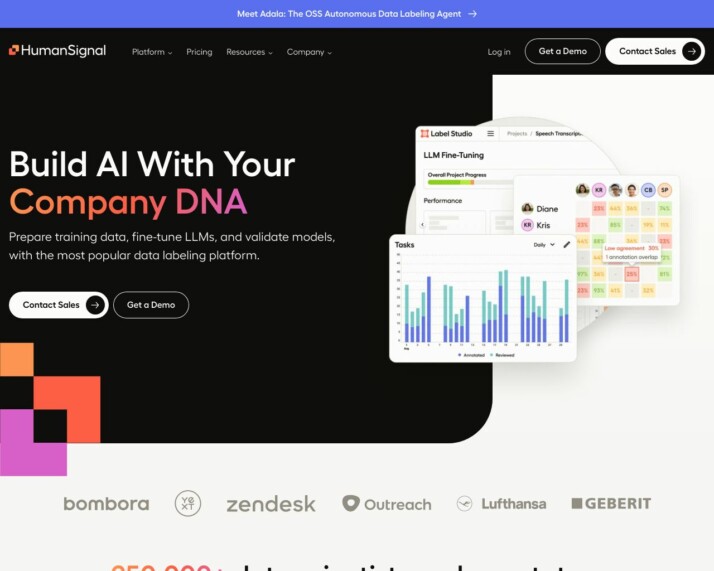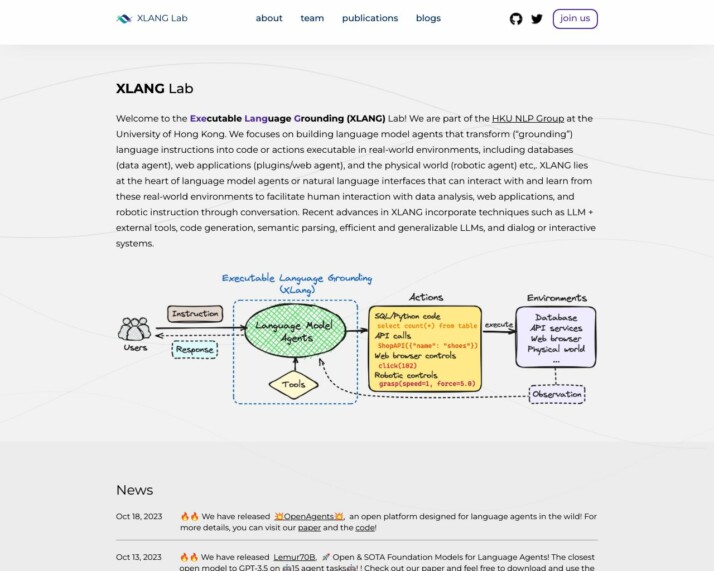Introduction
In an age where artificial intelligence and automation are becoming increasingly prevalent, platforms like Adala and OpenAgents have emerged as notable players in the field. Each platform brings to the table a unique blend of technological prowess and trend-setting features aimed to overhaul our traditional processes and systems.
Adala, known for its robust mechanisms and user-friendly interface, is certainly making waves in the industry. On the other hand, OpenAgents, famed for its versatility and strategic edge, provides an equally compelling proposition.
In this article, we will dive deep into a detailed comparison of these two giants, dissecting their offerings, exploring their intended audiences and, ultimately, drawing a conclusion to guide you in choosing the platform that suits your needs best. So sit back, relax, and let this exploration of Adala and OpenAgents enlighten your decision-making process.
An Overview of Adala: Features and Vision
Adala, an innovative solution crafted for handling complex data tasks, comes packed with unique offerings and tailor-made features for a specified target audience. In the realm of data interpretation, Adala shines in its function as a reliable tool for text-based tasks such as data labeling, classification, and summarization.


One of the unique selling points of Adala lies in its problem-solving capabilities. Its in-built agents are able to handle and resolve a variety of complex tasks associated with data processing.
This opens up a world of possibilities for the AI engineers and other professionals involved in architecting agent systems. Furthermore, Adala opens avenues for Machine Learning researchers to experiment with problem decomposition and causal reasoning.
Another advantageous aspect of Adala is their support for Human-AI Interaction, a feature integrated for the convenience of data scientists. This unique attribute allows interaction with AI agents via Python notebooks, a tool familiar to many data scientists. Moreover, Adala exhibits constrained alignment. Adala has a modular architecture, designed for community contributions. It is goal-oriented, intending to increase efficiency and reduce costs.
An important attribute of Adala is its specialization in TXT file support. The system has the ability to analyze and process plain text files, which is an added advantage when dealing with text-based data. Adala also integrates with renowned models like ChatGPT, providing a strong base for its operations.
However, it’s worth mentioning that Adala majorly focuses on code-based implementations and doesn’t support a no-code environment for agent creation. It also lacks debug mode or features providing insight into the AI’s decision-making process. Despite these, the capability of Adala’s agents to learn and improve over time from interactions with the environment clearly indicates their memory and context capabilities.
The target audience for the Adala framework primarily includes AI engineers, Machine Learning researchers, and data scientists. These individuals greatly benefit from the various features and applications that Adala offers for data processing, classification, and summarization. The open-source nature of the software also suggests a wider appeal to a community of developers keen on contributing to and expanding its capabilities.
The company’s vision with Adala is to provide a user-friendly platform. It aims to constantly improve data processing tasks by combining AI with inputs from humans. Through this blend of human interaction and technology, Adala stands out in the world of AI for its remarkable adaptability and reliability.
Exploring the Vision and Unique Features of OpenAgents
OpenAgents is a revolutionary platform that brings the power of AI (Artificial Intelligence) into everyday life, effectively bridging the gap between expert and non-expert users. The main vision of OpenAgents is to create an open platform that seamlessly integrates language agents into daily life, providing practical tools and agents to address real-world challenges.


The platform’s approach doesn’t just focus on general interaction, but offers tangible solutions and guidance in various scenarios like data analysis, web browsing, and task automation. Highlighting the company’s dedication to making AI and language agents more accessible and functional in everyday contexts.
OpenAgents houses three main agents on their platform, these include the DataAgent, PluginsAgent, and WebAgent. All of these agents can be used for free and are active in both development and production environments. With their user-friendly interface, comprehensive guidance, and hosting services, OpenAgents maintains a steady user base and server traffic.
The DataAgent stands out as it simplifies complex tasks related to data analysis and effectively handles large volumes of data, making it particularly helpful for professionals dealing with data insights.
The PluginsAgent, with over 200 integrated plugins, caters to a vast range of daily tasks and activities. The WebAgent is uniquely designed for autonomous web browsing, employing a Chrome extension to improve the internet experience.
These distinguishing features, along with the integration of new agents and plugins, make OpenAgents an innovate and versatile AI solution for their target audience.
Feature Comparison: Adala and OpenAgents vs SmythOS
Understanding and comparing the features of Adala, OpenAgents, and SmythOS can assist users in making informed decisions about the best platform. A detailed table below showcases the most important differences between Adala and OpenAgents features.
| Features | Adala | OpenAgents | SmythOS |
|---|---|---|---|
| Hosted Agents (Dev, Production) | ❌ | ✅ | ✅ |
| Autonomous Agents | ❌ | ✅ | ✅ |
| Explainability and Transparency | ❌ | ✅ | ✅ |
| OAuth | ❌ | ✅ | ✅ |
| Zapier APIs | ❌ | ✅ | ✅ |
| Deploy as API | ❌ | ✅ | ✅ |
| API Auth (OAuth+Key) | ❌ | ✅ | ✅ |
| Deploy as Site Chat | ❌ | ✅ | ✅ |
| Hosted Vector Database | ❌ | ❌ | ✅ |
| IP Control | ❌ | ❌ | ✅ |
The feature comparison table above delineates the differences between the features of Adala, OpenAgents, and SmythOS. However, more than just a simple list of capabilities, the impact of these features on the end-user experience is inestimable. For instance, features such as ‘OAuth’, ‘Deploy as API’, or ‘Autonomous Agents’, significantly influence the ease of use, range of applicability, and efficiency of the solutions.
The absence of ‘Hosted Agents (Dev, Production)’ and ‘API Auth (OAuth+Key)’ in Adala might present a limitation for some users. On the other hand, OpenAgents’ inability to support ‘Hosted Vector Database’ and ‘IP Control’, which SmythOS provides, might affect its competitiveness. The detailed understanding and analysis of these features could greatly assist users in choosing the most appropriate platform for their specific needs.
Adala and OpenAgents: Audience Analysis
The target audience for the Adala framework primarily consists of data scientists, AI engineers, and machine learning researchers. Adala is tailored to meet the needs of data scientists in preprocessing and postprocessing data, providing a user-friendly interface for interaction through Python notebooks.
This allows data scientists to apply Adala’s capabilities directly within their familiar workflow and data environments. The framework also appeals to AI engineers who are looking to develop production-level agent systems without delving deeply into the complexities of machine learning algorithms.
For machine learning researchers, Adala offers an environment to experiment with complex problem decomposition and causal reasoning. It provides a base for testing and refining new methodologies and techniques in AI and machine learning.
The end users of Adala are professionals in the field of AI, machine learning, and data science. The features and applications of Adala cater to those who require tools for efficient and effective data processing, such as data labeling, classification, and summarization. Additionally, Adala enables the development and implementation of autonomous AI agents.
The framework’s open-source nature also suggests an appeal to a community of developers who are keen on contributing to and expanding its capabilities.
OpenAgents, on the other hand, targets a diverse audience ranging from data professionals and general consumers to tech enthusiasts and non-experts. Its varied features and applications cater to the needs of these different user groups, making it a versatile and accessible platform for integrating AI and language agents into everyday life.
SuperAgent, with its combination of AI model integration, data handling capabilities, cloud infrastructure, and workflow management tools, is especially appealing to a technically adept audience seeking to develop, deploy, and manage advanced AI assistants and applications.
The target audience for the Adala framework includes data scientists, AI engineers, and machine learning researchers, whereas OpenAgents aims to cater to data professionals, general consumers, tech enthusiasts, and non-experts. SuperAgent targets a more technically adept audience, including AI researchers and enthusiasts, IT and systems administrators, businesses and organizations, and data scientists and analysts.
Conclusion
In summary, when comparing Adala and OpenAgents, it is clear that both frameworks have their strengths and weaknesses.
Adala, an open-source framework, is designed to meet the needs of data scientists in preprocessing and postprocessing data. It offers interaction through Python notebooks, making it convenient for data scientists to apply Adala’s capabilities within their familiar workflow and data environments.
Adala’s modular architecture encourages community involvement, with the goal of increasing efficiency and reducing costs of data labeling while maintaining high quality through human guidance.
On the other hand, OpenAgents presents a novel and versatile platform that integrates voice agents into everyday life. With specialized agents such as the DataAgent, PluginsAgent, and WebAgent, OpenAgents offers a wide range of capabilities for data analysis, daily tasks, and autonomous web browsing. The extensive plugin integration and the ability to automate web browsing through a Chrome extension are standout features of OpenAgents.
While both frameworks have their merits, SmythOS stands above the rest as the preferred choice for businesses and organizations. SmythOS provides advanced AI model integration, robust data handling capabilities, cloud infrastructure, and workflow management tools. Its ability to handle complex workflows and provide meaningful interactions with users through AI assistants makes it a valuable tool for various applications.
Additionally, SmythOS prioritizes explainability and transparency, offering insight into the AI’s decision-making process and supporting the concept of reusable logic gates.
SmythOS outshines its competitors by combining advanced AI capabilities with user-friendly features and a strong focus on reliability and explainability. Its unique combination of AI model integration, data handling capabilities, and workflow management tools makes it the top choice for businesses and organizations looking to leverage AI for various applications.
Last updated:
Disclaimer: The information presented in this article is for general informational purposes only and is provided as is. While we strive to keep the content up-to-date and accurate, we make no representations or warranties of any kind, express or implied, about the completeness, accuracy, reliability, suitability, or availability of the information contained in this article.
Any reliance you place on such information is strictly at your own risk. We reserve the right to make additions, deletions, or modifications to the contents of this article at any time without prior notice.
In no event will we be liable for any loss or damage including without limitation, indirect or consequential loss or damage, or any loss or damage whatsoever arising from loss of data, profits, or any other loss not specified herein arising out of, or in connection with, the use of this article.
Despite our best efforts, this article may contain oversights, errors, or omissions. If you notice any inaccuracies or have concerns about the content, please report them through our content feedback form. Your input helps us maintain the quality and reliability of our information.
Alexander De Ridder
Co-Founder, Visionary, and CTO at SmythOS. Alexander crafts AI tools and solutions for enterprises and the web. He is a smart creative, a builder of amazing things. He loves to study “how” and “why” humans and AI make decisions.
Explore All Comparison Articles
Decisions vs. Sola: AI Workflow Automation Showdown
AI-powered workflow automation platforms revolutionize how businesses streamline operations and boost productivity. This comparison explores Decisions vs. Sola, and SmythOS,…
DeepOpinion vs. Sola: Comparing AI Automation Platforms
AI-powered automation platforms revolutionize business operations, but choosing the right solution can be challenging. This comparison of DeepOpinion vs. Sola,…
DevGPT vs. Sola: AI-Powered Development Tools Compared
AI-powered development tools revolutionize software creation, offering unprecedented efficiency and capabilities. This comprehensive review compares DevGPT vs. Sola, and SmythOS,…
Fine AI vs. Sola: Comparing AI Automation Tools
AI-powered automation transforms software development and business workflows, offering unprecedented efficiency and innovation. Fine AI vs. Sola present distinct approaches…
FlowiseAI vs. Sola: Comparing AI Automation Platforms
AI-powered automation revolutionizes business operations, driving efficiency and innovation across industries. FlowiseAI vs. Sola offer distinct approaches to harness this…
Gooey AI vs. Sola: AI-Powered Automation Platforms Compared
AI-powered automation platforms revolutionize how businesses streamline operations and enhance productivity. This comparison delves into Gooey AI vs. Sola, two…

